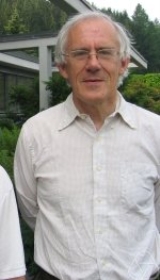
Charles Leedham-Green
Encyclopedia
Charles R. Leedham-Green is a retired professor of mathematics
at Queen Mary, University of London
, known for his work in group theory
. He completed his DPhil at the University of Oxford
.
Along with Leonard Soicher, Leedham-Green designed the product replacement algorithm; an algorithm within computational group theory
that generates random elements of groups by taking a random walk
through the group. This algorithm has been implemented in both GAP
and MAGMA
.
He is responsible for a great body of work in group theory. In recent times, this has involved research in computational group theory and pro-p group
s.
The 300th edition of the Journal of Algebra
was dedicated to him for his 65th birthday.
On the occasion of his retirement in 2006, the Mathematics Research Centre at Queen Mary held a conference in celebration of his mathematical achievements.
Mathematics
Mathematics is the study of quantity, space, structure, and change. Mathematicians seek out patterns and formulate new conjectures. Mathematicians resolve the truth or falsity of conjectures by mathematical proofs, which are arguments sufficient to convince other mathematicians of their validity...
at Queen Mary, University of London
Queen Mary, University of London
Queen Mary, University of London is a public research university located in London, United Kingdom and a constituent college of the federal University of London...
, known for his work in group theory
Group theory
In mathematics and abstract algebra, group theory studies the algebraic structures known as groups.The concept of a group is central to abstract algebra: other well-known algebraic structures, such as rings, fields, and vector spaces can all be seen as groups endowed with additional operations and...
. He completed his DPhil at the University of Oxford
University of Oxford
The University of Oxford is a university located in Oxford, United Kingdom. It is the second-oldest surviving university in the world and the oldest in the English-speaking world. Although its exact date of foundation is unclear, there is evidence of teaching as far back as 1096...
.
Along with Leonard Soicher, Leedham-Green designed the product replacement algorithm; an algorithm within computational group theory
Computational group theory
In mathematics, computational group theory is the study ofgroups by means of computers. It is concernedwith designing and analysing algorithms anddata structures to compute information about groups...
that generates random elements of groups by taking a random walk
Random walk
A random walk, sometimes denoted RW, is a mathematical formalisation of a trajectory that consists of taking successive random steps. For example, the path traced by a molecule as it travels in a liquid or a gas, the search path of a foraging animal, the price of a fluctuating stock and the...
through the group. This algorithm has been implemented in both GAP
GAP computer algebra system
GAP is a computer algebra system for computational discrete algebra with particular emphasis on computational group theory.-History:...
and MAGMA
MAGMA
MAGMA Gießereitechnologie GmbH develops and markets software for casting process simulation. The software is used world-wide by foundries, casting buyers and designers. In addition to the simulation software MAGMASOFT®, respectively MAGMA5, the product and service portfolio includes engineering...
.
He is responsible for a great body of work in group theory. In recent times, this has involved research in computational group theory and pro-p group
Pro-p group
In mathematics, a pro-p group is a profinite group G such that for any open normal subgroup N\triangleleft G the quotient group G/N is a p-group...
s.
The 300th edition of the Journal of Algebra
Journal of Algebra
Journal of Algebra is a leading international mathematical research journal in algebra. An imprint of Academic Press, it is presently published by Elsevier. Journal of Algebra was founded by Graham Higman, who was its editor from 1964 to 1984. From 1985 until 2000, Walter Feit served as its...
was dedicated to him for his 65th birthday.
On the occasion of his retirement in 2006, the Mathematics Research Centre at Queen Mary held a conference in celebration of his mathematical achievements.
Selected publications
- Charles R. Leedham-Green, Leonard H. Soicher: Collection from the Left and Other Strategies. J. Symb. Comput. 9(5/6): 665-675 (1990)
- Charles R. Leedham-Green, Cheryl E. Praeger, Leonard H. Soicher: Computing with Group Homomorphisms. J. Symb. Comput. 12(4/5): 527-532 (1991)
- Derek F. Holt, C. R. Leedham-Green, E. A. O'Brien and Sarah Rees: Testing Matrix Groups for Primitivity. Journal of Algebra, Volume 184, Issue 3, 15 September 1996, Pages 795-817
- Derek F. Holt, C. R. Leedham-Green, E. A. O'Brien and Sarah Rees: Computing Matrix Group Decompositions with Respect to a Normal Subgroup. Journal of Algebra, Volume 184, Issue 3, 15 September 1996, Pages 818-838.
- C. R. Leedham-Green and E. A. O'Brien: Tensor Products are Projective Geometries. Journal of Algebra, Volume 189, Issue 2, 15 March 1997, Pages 514-528
- Robert Beals, Charles R. Leedham-Green, Alice C. Niemeyer, Cheryl E. Praeger, Ákos Seress: Permutations With Restricted Cycle Structure And An Algorithmic Application. Combinatorics, Probability & Computing 11(5): (2002)
- C. R. Leedham-Green and E. A. O'Brien: Recognising tensor-induced matrix groups. Journal of Algebra, Volume 253, Issue 1, 1 July 2002, Pages 14–30
- Nigel Boston and Charles Leedham-Green: Explicit computation of Galois p-groups unramified at p. Journal of Algebra, Volume 256, Issue 2, 15 October 2002, Pages 402-413.
- Charles Leedham-Green and Sue McKay: The Structure of Groups of Prime Power Order (2002)
- John J. Cannon, Bettina Eick, Charles R. Leedham-Green: Special polycyclic generating sequences for finite soluble groups. J. Symb. Comput. 38(5): 1445-1460 (2004)
- Robert Beals, Charles R. Leedham-Green, Alice C. Niemeyer, Cheryl E. Praeger and Ákos Seress: Constructive recognition of finite alternating and symmetric groups acting as matrix groups on their natural permutation modules. Journal of Algebra, Volume 292, Issue 1, 1 October 2005, Pages 4–46
- S.P. Glasby, C.R. Leedham-Green and E.A. O'Brien: Writing projective representations over subfields. Journal of Algebra, Volume 295, Issue 1, 1 January 2006, Pages 51–61

